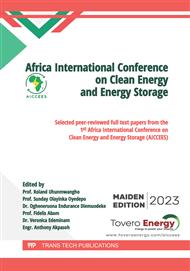p.3
p.15
p.27
p.43
p.57
p.67
p.81
p.91
Development of an Optimized Energy System for Powering Base Transceiver Stations in Calabar, Nigeria
Abstract:
Energy system plays an important role in the transition towards a sustainable urban life. Enhancing the quality of a livable environment through drastic reduction of pollutant emissions from fossil-fuelled generators can be achieved via the utilization of renewable energy sources. Hybrid renewable energy technologies can reliably meet the energy demands of base transceiver stations (BTS) located in off-grid rural villages. This paper aims to optimize and assess the performance of a hybrid energy system to meet the electrical load requirements of a BTS located in in Calabar, Nigeria using an off-grid hybrid system. Optimizing the control, sizing, and components of such a system aims to provide cost-effective power to these communities. The key objectives are minimizing cost of energy, total net present cost, CO2 emissions and unmet load using HOMER software. The results from the four different energy configurations were evaluated to determine the most optimized combination for the region. From the results obtained, there was a considerable variation in the optimum system configuration based on the different potential renewable energy resources. The result shows that the PV/wind/hydro/battery had a levelized cost of electricity (LCOE) as $2.40; PV/hydro/battery had $2.05; PV/wind/battery had $1.64; hydro/battery had $2.05; PV/battery had $1.38 & wind/battery had $5.44. However, due to the low wind and solar penetration in Ogoja, Nigeria, more storage systems were required for configurations without hydro component and large-scale hybrid energy systems with higher LCOE. The configuration system that showed moderate hybrid system sizes with LCOE of $1.38 was the PV/battery system with 0% energy unmet.
Info:
Periodical:
Pages:
27-42
Citation:
Online since:
March 2024
Price:
Сopyright:
© 2024 Trans Tech Publications Ltd. All Rights Reserved
Share:
Citation:


